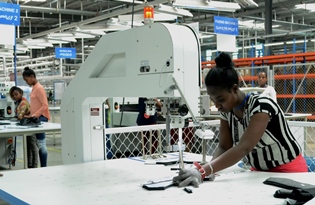By Andualem Sisay Gessesse – Hawassa, Ethiopia–
In summary: Following the economic growth of Asian and Far East countries that resulted in an increase of wage of the employees, global textiles giants have been considering Africa as their next destination. Ethiopia has emerged as one of the countries in Africa showing great interest in hosting these companies with a vision of becoming the continent’s manufacturing hub.
As the country celebrates the production commencement of Hawassa Industrial Park on Tuesday, employees of some of the textile factories in the Park say they are having difficulty to make a living with less than $1.5 a day wage. The World Bank considers people who earn less than $1.90 per day as living under poverty line. Andualem Sisay investigates whether Ethiopia’s emerging textiles industry, which relies on workers living under poverty line, is sustainable.
On Sunday, June 18, 2017, Addis Ababa-based Journalists are invited by the government to visit some of the new textiles factories in Ethiopia’s first environment-friendly Hawassa Industrial Park (HIP).The park is named after one of the fastest growing city of Ethiopia – Hawassa, which is located 270 kilometers south of the capital-Addis Ababa.
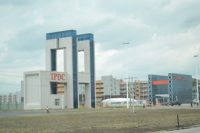
It was a few months back that Etagu Amsaro, 27, was first informed by the people in the Wereda (a government structure at a lower level) about the availability of a job for her in Hawassa.
After passing through the screening and selection process she is selected as the candidate for the job at HIP. She then relocated to Hawassa leaving her family in Bensa Daye of Sidama Zone, which is 120 kilometers from Hawassa. “I am not the only one there were many girls who came with me but they are now working in different factories,” she says.
She is among some 30,000 youth who are registered from the surrounding towns for screening to get a job at HIP. But after she is relocated, life was not easy as for her. The 1,002 birr (around $43 at the prevailing exchange rate) monthly wage she earns from one of the 18 textiles factories in the Park is far too small. It can’t cover at least the cost for her meals, house rent and transportation.
“Our salary is actually 650 birr (around $28) per month. They give [Silver Spark Apparel Ethiopia Private Limited Company of Indian] us a total of 1,002 birr adding for transport and lunch. This is not enough for me to make a living renting a house in Hawassa,” she, says, indicating that she and her two friends are sharing rent cost for a small one room. Tesfanesh Lemesa is another female employee working in the next door shed in HIP, which is co-owned by Chinese and U.S investors.
She began working in JP Textile Ethiopia Private Limited Company about two months ago. Like Silver Spark, this factory has also not yet started production at its full capacity. She gets paid 850 birr (around $37) per month. But unlike Etagu, she gets free lunch at the factory. She came from Durame town area some 50 kilometers and settled in Hawassa city.
Next door HIP Tsega sells foods, coffee and tea in one of dozens of ‘plastic shed restaurants’. “Some of HIP employees eat their lunch here and in other similar restaurants next door,” she says. Boiled potato sauce with three small flat pieces of bread made of corn (Kitta) is the cheapest meal most of HIP employees go for, according to Tsega whose clients also include daily laborers in construction sector who earn between 40 – 50 birr (over $1.7 – close to $2.2) per day.
The cheapest rent for a small house ranging between 650 – 800 birr (between $28-around$35) per month is only available in Chefe and Monopol area, which are located at the outskirt of Hawassa city. As these places are 3 to 5 kilometers away from HIP, the taxis charge five birr for one way.
“…Because most of them can’t afford that, they walk and at times get their mobile phones snatched by street vagabonds,” says one of the security guards recruited by an agency for 2,000 birr (around $87) a month.
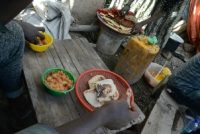
“Many of them report to us about this frequently we ask them why they are late for work and why they look exhausted,” he says, stating that he and many of HIP employees live in Monopol area while others also are in Chefe area.
If an employee of HIP such as, Etagu spends 3 birr for a bread and tea breakfast daily and is forced to eat the cheapest meals available for lunch and dinner – like the one Tsega sells in the plastic sheds, she/he needs 390 birr (close to $17) a month.
She/he also needs around 300 birr ($13) per month for transportation from HIP to Chefe/Monopol and back to the factory. And if that individual pays the cheapest room available in the city – 650 birr ($28), she/he needs to earn at least 1,340 birr ($58) per month. This is of course if the house rent includes water and electricity bill and that person never takes tea or coffee.
People who earn less than $1.90 per day are considered as ‘living below poverty line’, according to the World Bank that increased the amount from $1.25 per day a few years ago.
“We rented a house in Hawassa city with other female employees because I can’t afford to rent a house alone. But since I had no job before but now I have one, I have not much to complain about at this stage,” Tesfanesh says, hoping that salary may get improved as the factory goes fully operational.
“Now the wage in Asia is getting more and more expensive as people have other avenues of livelihood,” says Vishal Bist, Business Head at Silver Spark Apparel Ethiopia Private Limited Company.
“The price of a shirt with a specific brand you bought ten years ago may not change that much if you buy that shirt today. Meanwhile, the salaries of the employees will definitely be increasing during those ten years. So that is why the industry is constantly trying to find the right balance,” says Mr. Bist who noted that the suits his company is now producing in Ethiopia with brands such as, Raimond and Esperante are exported between $30-$40 while the retail price in the United States or the European Union can usually be four times this price.
“The wages that we pay are going to be in line with the global market. The forces of economics do not allow to disproportionately high or disproportionately low,” he argues, stating that Ethiopia has still to go 20-25 years to reach where the countries that increased their wages
for textiles sector because the people have got other better-paying alternatives.
In search of cheap labor destinations like Ethiopia, relocating their factories from one country to another has been one of the major strategies of textile factories for the past several decades.
After two years when all the 18 textiles factories fully commence operation, HIP is expected to create jobs for 60,000 youth and generate one billion U.S. dollars export revenue. Just like HIP within two years period, the government also hopes to have a total of 15 different industrial parks across the country and create two million jobs for the youth.
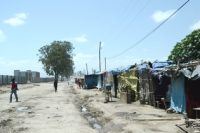
It is argued that the benefits of providing jobs for the likes of Etagu and Tesfanesh and tens of thousands of youth who had no prior experience in the textiles industry at all, has much more benefits for the country and the society than just monetary value.
But the issue also needs immediate attention by the government before the frustration in the making in the minds of HIP employees grows and infects the attitudes of the emerging generation and the society in general towards Ethiopia’s industrial parks as well as those who are forced ‘ to work and live below poverty line’.
“I suggest they should cover our house renting cost at least or increase our salary,” Etagu says, responding to what she would like to be improved at the factory.
Prime Minister Hailemariam Desalegn of Ethiopia, who spoke at the inaugural of HIP this morning said: “…Indeed one can say construction of sheds in industrial parks is fairly easy… the complicated and the challenging job is to turn our vision into concrete result and full success.”
At the end of this month, the total number of jobs created at HIP by the textiles factories is estimated to reach 10,000. “Our vision is to become Africa’s manufacturing hub by 2025,” said Prime Minister Hailemariam Desalegn speaking at the inauguration of HIP. “We aim is to create millions of jobs in labor-intensive light manufacturing industries,” he said.
All HIP employees have gone through a job screening by the association of the textiles factories and got both soft and skills training before employment.
“Before they become employees, they got one-week soft training on such as work ethics and discipline as well as one-month skills training in the factories,” says Dr. Belachew Mekuria head of Industrial Park Development section at Ethiopian Investment Commission.
Ethiopia, which is a nation of young generation with some cities unemployment rate reaching as high as 24%, has long been trying to develop job-intensive industries.
Close to Hawassa Airport and an electric-railway that links to Port of Djibouti, HIP has a total of 52 sheds constructed on a land of 26,000 square meters. It also has 1,000 houses built for the expats who work in the factories.
While two in Addis are already operational, three more are expected to be inaugurated in the coming few months. The country plans to complete
the construction of the sheds of in all the 15 special industrial parks within two years period.
The initiative has three main objectives among others, speeding the transformation of Ethiopian agrarian economy to industrialization, boosting the export revenue of the country and reducing the trade balance deficit as well as creating millions of jobs in the light manufacturing industries.
“This is the beginning; we need to change and bring suitable business environment in our country,” Dr. Arkebe Okubay, Advisor to the Prime Minister Hailemariam Desalegn, said, mentioning that it is a disgrace for the country to continue receiving food aid and see its citizens migrating illegally risking their lives while Ethiopia has the potential and opportunity to change its history for good.
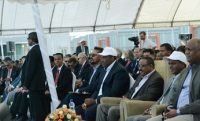
Trained in China
Before the construction of HIP commences, JP Textile Ethiopia PLC, a joint venture of Chinese and American investors, selected 25 Ethiopians who are graduated in textiles from a university and trained them Mandarin – Chinese language – in Addis Ababa for eight months.
They then went to Shanghai to get on job skills training on weaving and making textiles and garment for six months. Coming back from the training, they took part in the installation of machineries for JP Textiles in HIP. They are now instrumental in teaching other Ethiopians JP Textiles is recruiting for its new garment factory.
“Though we study the science at a university here, what we have seen during our stay is very new to us and practical. We learned new techniques. We are now sharing this knowledge with other colleagues in this factory,” said Wossen Niguse, who is graduated in textile from Bahir Dar University in Ethiopia and one of the 25 trainees, went to China for practical knowledge.
The construction of HIP, which provides all the government facilities for the factories including visa issuing, customs services, power substation with a waste water treatment and recycling plant has taken 11 months. What is required from the companies is to bring their machineries duty-free, install, train their employees for few weeks then start production.
The government believes that the new plugin and play industrial park is much more efficient and reduces the several years an investor spends before starting production to six months. Securing land, building a factory on their own, getting other government services by moving from agency to another, were among the major headaches investors were complaining about.
Like HIP, which took 11 months to complete construction, the government is planning to inaugurate two parks – Mekele Industrial Park and Kombolcha Industrial Park – in the coming September, according to Dr. Arkebe, who briefed journalists on Sunday in Hawassa a day ahead of the inauguration of HIP.
Unlike the previous model of industrial zones in which Ethiopia tried to create industrial zones for all sort of industries in one place and/or for one nation such as Chinese industrial zone, Turkish and the like, the new approach focuses on one specialized industry park that focuses one sector/industry.
Most of the factories in HIP will be exporting to the United States and European markets where Ethiopia can access export duty-free privileges. With retail stores across the United States PVH Corporation, which owns some of best global brands such as, Calvin Klein is also at the forefront of the establishment of HIP and is engaged for the first time in the manufacturing of textiles.
Environment-friendly industries
The new model though targets the already priority focus industries of the country textiles, pharmaceuticals, chemicals, leather, and agro-processing, it aims to attach each park to raw materials and logistics such the railway route that ease import and export of the factories.
Most of all it also aims to make all the future industries of the country climate friendly and non-environment pollutant.The zero liquid discharge plant installed in HIP treats recycles and uses 90% of the industrial water.
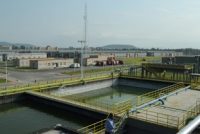
“The water treatment plant has the capacity of treating 11 million liters of water daily. The fact that we reuse the 90% of the water means saving that much amount of water from being pumped from the ground every day,” says Lalit Kewalramani, chief project manager of Arvind, an Indian company, which installed the water treatment system and handles the operation for the coming two years.
The cost for such water treatment facility including construction may reach $2.5 million for installation of a plant with a capacity of treating one million liters water per day, according to Mr. Kewalramani.
He estimated the total cost for HIP water treatment facility to be around $27.5 million had it been done by Arvind, which signed MOU to implement the same water treatment for all the remaining 14 industrial parks on the pipeline. Including the water sewerage treatment plant, the Ethiopian government has invested a total of $300 million dollars for HIP.

